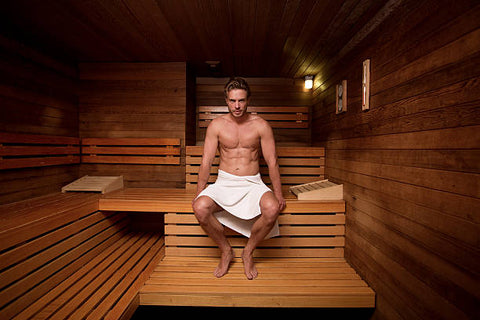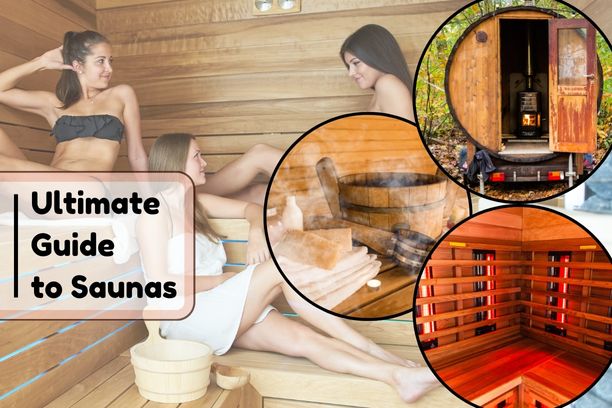Key Takeaways
· The best infrared sauna for home offers customizable heat and deep relaxation while supporting detoxification, pain relief, and skin health.
· Understanding traditional, infrared, hybrid, steam, and portable home sauna types helps you match your health and lifestyle needs.
· Home sauna installation should consider size, materials, seating, and location to maximize the wellness benefits and comfort.
· Luxury home sauna options use high-quality cedar, ergonomic seating, and advanced heat sources for superior at-home spa experiences.
· Choosing the right type of sauna can enhance your home sauna wellness routine by supporting stress relief, heart health, and a youthful glow.
Saunas have been used for centuries for various health benefits, including rejuvenation and relaxation. The units originated in Finland and have evolved over the years to be used worldwide.
Whether you're using the sauna for the first time or are a seasoned enthusiast, it's important to understand the different types of saunas available, their benefits, and how to choose the ideal one for your needs. Join us as we delve further into the world of saunas.
Understanding the Different Types of Saunas Available
There are numerous types of saunas available for the sauna enthusiast. These include:
Traditional Saunas
Traditional saunas are heated by wood or an electric heater. Water is poured on the rocks to generate steam, which heats the unit's surroundings. The traditional sauna can be placed outdoors or indoors, and it takes approximately 40 minutes to heat up appropriately. The temperature inside traditional saunas can hit 185 degrees and sometimes more.
Hybrid Saunas
Hybrid saunas are an advanced combination of traditional and infrared units designed for people seeking to enhance their sweating experience. You can use them as either an infrared or traditional sauna or a combination. Usually, their temperature and the time it takes to heat up depend on your choice of heating.
Infrared Saunas
Unlike the traditional sauna, infrared saunas generate more sweat. These units rely on infrared waves to heat up and raise your body's core temperature. Instead of heating the entire room, infrared heat targets your body.
Compared to the traditional sauna, the temperature inside infrared units is way lower. The temperature inside infrared saunas can reach 130 degrees Fahrenheit. Infrared saunas take up to 20 minutes to heat up.
Tip: For those wanting cutting-edge wellness at home, choosing a quality full-spectrum infrared sauna for sale will help you access deep heat, low EMF, and tech-savvy features. Learn more in the blog Best Infrared Saunas in 2025 (Reviewed by Experts).
Steam Saunas
Also known as a steam room, a steam sauna heats up by generating steam discharged into the unit at regular intervals. These saunas are popular in gyms and are heated through a steam generator that boils water, converts it into steam, and continually releases it into the unit. While the temperature inside a steam sauna is usually lower, the high humidity makes the unit feel warmer. Steam rooms are made of plastic, glass, and tiles, making them easy to clean.
Portable Home Sauna
Portable home saunas are ideal for steam enthusiasts who enjoy sauna sessions on the go. They are portable and cheaper than other types of saunas discussed above. To use them, you only need to get inside and switch on the steamer to begin your sauna session. Portable saunas are available in different sizes and shapes and feature an infrared heating mechanism.
Why You May Need a Sauna (Home Sauna Wellness)
Saunas have become popular worldwide for various reasons, such as:
Enhancing Well-Being and Overall Health
Research suggests that having regular sauna sessions can help reduce pain and stress levels. In a study conducted in 2019, researchers revealed that saunas can effectively reduce lower back pain.
Another Finnish study established that using the sauna can lower the risk of developing heart disease and elongate life expectancy. The study further revealed that having three sauna sessions weekly lowers the risk of sudden cardiac-related complications. Besides their physical benefits, saunas help you relax away from the hustles and bustles of everyday life.
Tip: Saunas offer proven infrared sauna health benefits for heart health, athletic recovery, relaxation, and more; the science behind regular use is growing rapidly.
Relaxation
Saunas provide an appropriate environment for people seeking relaxation. The body's response to the heat can promote attentiveness, reduce susceptibility to pain, and make you happier. Spending time inside the sauna also relaxes the muscles around your head and neck.
Regular sauna sessions help you connect with your emotions and can be a great meditation opportunity. Whether you're a professional athlete or workout enthusiast, saunas help relax your muscles after vigorous exercise.
Glowing Skin
Sweating stimulates the production of more nutrients and oxygen on the surface of your skin, triggering skin cell regeneration and helping your skin look healthier. Regular sauna sessions help moisturize your face and body without using clog-causing harmful chemicals.
As you grow older, managing aging symptoms becomes your core focus. Sweating inside the sauna stimulates your body to produce more collagen, improving the appearance of your skin. The temperature inside a sauna can play a big role in clearing dead skin cells.
Detoxification
Detoxification occurs when the body excretes accumulated toxins from its system through the organs, tissue, and muscles. It is worth mentioning that the sauna is not a detoxifier. However, it facilitates the elimination of toxins via sweating through the skin. Studies have revealed that organochlorinated pesticides (OCPs) and bisphenol A can be eliminated from the body through sweating.
See how an infrared sauna benefits detox processes: Does Sauna Help Detox? Exploring the Facts (for an in-depth look at the science).
Choosing the Ideal Sauna for Your Needs

Various considerations should be made before choosing a sauna, as seen below.
Size
Studies suggest that the standard sauna height should be seven feet, perfect for reducing heat loss. Still, you can choose a small sauna, four by four feet. But if you plan to accommodate multiple people in the sauna, an eight-by-12-foot sauna would be appropriate.
The available space within your home or compound determines the size of your sauna. Additionally, you must consider how you plan to use the unit. Will multiple people be using it at the same time? What additional structures do you plan to incorporate inside the sauna? Remember, the more structures in the sauna, the more space you need.
Tip: If you want flexibility and fast installation, consider an outdoor infrared sauna. Modern weatherproof and insulated designs fit nearly any space. There is an infrared sauna 1-person outdoor or indoor model too!
Materials
The classic material for saunas is wood, with cedar being the most common. Cedar is a hardwood that hardly splinters. Further, it contains cedarwood oil, which makes it rot-resistant.
Additionally, cedar discharges a pleasant scent upon heating. Spruce and pine are popular options that discharge a nice smell when heated. The material you choose should retain heat without making the unit uncomfortable for users. More reading: What Kind of Wood Is Best for a Sauna?
Seating
What type of seating do you prefer for your sauna? Commercial saunas usually feature benches in tiered rows. Consider having two-tiered benches, with the lower bench as a footrest and step stool for users sitting on the higher bench.
The tiered benches are ideal for multiple-user saunas. Remember, every sauna user will need approximately two feet of space inside and six feet to facilitate reclining. The unit should be between 18 to 24 inches deep for comfort. If users are reclining, then the sauna should have a lounging bench.
Tip: For families, the 2–3-person home sauna benefits include shared health sessions, connection, and spacious comfort for everyone.
Location
Before choosing a sauna, you must choose an indoor or outdoor unit. If you prefer an indoor sauna, having enough space in your surroundings is key. The advantage of an indoor sauna is that nearly all the structures you need are available, making construction less costly and easier. While outdoor saunas can be costlier, they allow you to experiment with the design and size.
If you opt for an outdoor sauna, you must identify an ideal location. Some people build the sauna close to their houses for easy access, while others incorporate it within their swimming pool area.
Weatherproof outdoor infrared sauna setups now fit nearly any climate or backyard. Explore considerations in Important Things to Consider When Getting an Outdoor Sauna.
Heat Source
You can choose between infrared light, an advanced technology, or the conventional external heat source. Traditional saunas use electric, gas, or wood-fired heating. However, sauna owners prefer electric heating, eliminating the manual and tiresome process of heating the sauna manually.
Tip: Not sure infrared sauna vs traditional sauna is right for you? Each has unique heating methods, installation requirements, and price points. Research both to choose your perfect fit.
Finally
Saunas offer various health benefits and promote overall well-being. As seen above, there are various considerations to make before choosing a sauna for your needs. Before buying a sauna, it's important to understand how to choose the one that best suits your needs.
Sun home Saunas sells some of world best Infrared Saunas, the popular infrared sauna blanket and home cold plunge tub setups so improve your heath by using our Infrared Saunas.
Reach out today and connect with our sauna experts to bring the full benefits of sauna therapy into your daily life.
FAQs
1. What are the key differences between sauna types for home wellness?
Traditional saunas use steam and high heat, infrared heats directly, hybrids combine both, and portable models offer flexibility for relaxation at home.
2. How do I select the best infrared sauna for home use?
Consider your space, heat preferences, installation style, and materials. Cedar is preferable for luxury home sauna builds.
3. Are there unique home sauna wellness benefits to infrared models?
Yes, infrared saunas provide deeper sweat, lower skin temperatures, and targeted relief for pain, detox, and relaxation.
4. What features matter most in home sauna installation?
Sauna height, bench design, heat source, and placement (indoor vs outdoor) all impact user comfort and efficiency.
5. Can a home sauna wellness regimen improve skin and overall health?
Regular sessions can brighten skin, support detoxification, boost immunity, and help manage pain for enhanced well-being.






